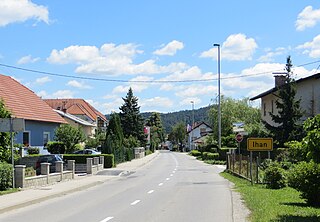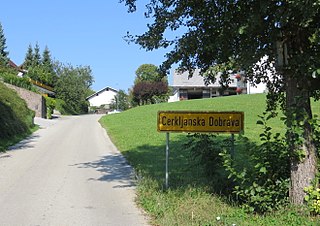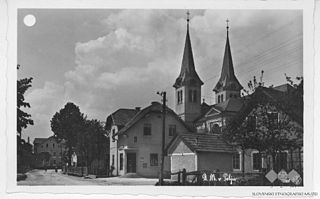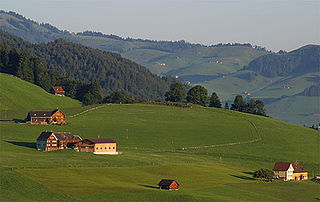
Ihan is a settlement in the Municipality of Domžale in the Upper Carniola region of Slovenia. The settlement used to be part of the Krumperk lordship. Today it is known for its pig farm, which is the largest in Slovenia.

Češenik is a settlement in the Municipality of Domžale in the Upper Carniola region of Slovenia.

Cerkljanska Dobrava is a small settlement in the Municipality of Cerklje na Gorenjskem in the Upper Carniola region of Slovenia.

Dolenja Dobrava is a small village on the right bank of the Poljane Sora River in the Municipality of Gorenja Vas–Poljane in the Upper Carniola region of Slovenia.

Hotovlja is a settlement on the right bank of the Poljane Sora River, opposite Poljane nad Škofjo Loko, in the Municipality of Gorenja Vas–Poljane in the Upper Carniola region of Slovenia.

Rigonce is a settlement in the Municipality of Brežice in eastern Slovenia. The area was traditionally part of Styria. It is now included with the rest of the municipality in the Lower Sava Statistical Region.

Drama is a village in the Municipality of Šentjernej in southeastern Slovenia. The area was traditionally part of Lower Carniola. It is now included in the Southeast Slovenia Statistical Region. It includes the hamlets of Dolenja Gomila, formerly an independent settlement, to the west and Otok to the northwest.

Češnjica is a settlement in central Slovenia. It lies in the hills east of the capital Ljubljana and belongs to the Ljubljana Urban Municipality. It was part of the traditional region of Lower Carniola and is now included with the rest of the municipality in the Central Slovenia Statistical Region.

Tuji Grm is a dispersed settlement in the hills south of the Sava River east of the capital Ljubljana in central Slovenia. It belongs to the City Municipality of Ljubljana. The area was part of the traditional region of Lower Carniola. It is now included with the rest of the municipality into the Central Slovenia Statistical Region.

Drtija is a settlement in the Municipality of Moravče in central Slovenia. The area is part of the traditional region of Upper Carniola. It is now included with the rest of the municipality in the Central Slovenia Statistical Region. The settlement includes the hamlets of Belnik, Brinje, Gorica, Kovačija, Podbrdo, Kuga, Štance Laze, Štebalija, Štorovje, and Straža. Before the First World War, the hamlets scattered along the Slivna Plateau were collectively known as Za Goro.

Studenec is a small settlement west of Trebnje in eastern Slovenia. The Municipality of Trebnje is included in the Southeast Slovenia Statistical Region. The entire area is part of the historical region of Lower Carniola.

Zdenska Vas is a village north of Videm in the Municipality of Dobrepolje in Slovenia. The area is part of the historical region of Lower Carniola. The municipality is now included in the Central Slovenia Statistical Region.

Polje is a former village in the western part of the City Municipality of Ljubljana, the capital of Slovenia.

Dobrava pri Črnučah is a formerly independent settlement in the northern part of the capital Ljubljana in central Slovenia. It is a dispersed settlement on both sides of the road from Ljubljana to Domžale. It was part of the traditional region of Upper Carniola and is now included with the rest of the municipality in the Central Slovenia Statistical Region.

Studenec is a formerly independent settlement in the southeast part of the capital Ljubljana in central Slovenia. It belongs to the City Municipality of Ljubljana. It was part of the traditional region of Upper Carniola and is now included with the rest of the municipality in the Central Slovenia Statistical Region.

Kaplja Vas is a formerly independent settlement in the southern part of the village of Komenda in central Slovenia. It belongs to the Municipality of Komenda. It was part of the traditional region of Upper Carniola and is now included with the rest of the municipality in the Central Slovenia Statistical Region.

Trata is a former settlement in central Slovenia in the northwest part of the capital Ljubljana. It belongs to the Šentvid District of the City Municipality of Ljubljana. It was part of the traditional region of Upper Carniola and is now included with the rest of the municipality in the Central Slovenia Statistical Region.

Reka is a right tributary of the Pšata River in Slovenia. It is formed by the confluence of two smaller creeks flowing from the Luknja Gorge and Brezovec Gorge below Mount Krvavec. It flows south through Cerklje na Gorenjskem. South of that, it is joined by a right tributary, Ušica Creek, before it joins the Pšata River at Komenda.

Tunjščica is a left tributary of the Pšata River in Slovenia. It is about 14 kilometers (8.7 mi) long and has its origin at 750 meters (2,460 ft) above sea level on the south slope of Mount Krvavec in the Kamnik–Savinja Alps above the hamlet of Senožeti in Sveti Lenart. It flows past or through Sidraž, Laniše, Tunjice, Tunjiška Mlaka, and Gora pri Komendi before emptying into the Pšata at Moste. Tributaries of Tunjščica Creek include Praproščica Creek.



















